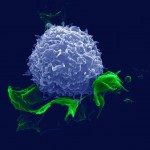Link to Pubmed [PMID] – 24753465
Contrast Media Mol Imaging 2015 Mar-Apr;10(2):111-21
Upregulation of intercellular adhesion molecule 1 (ICAM-1) is an early event in lesion formation in multiple sclerosis (MS) and experimental autoimmune encephalomyelitis (EAE), an animal model of MS. Monitoring its expression may provide a biomarker for early disease activity and allow validation of anti-inflammatory interventions. Our objective was therefore to explore whether ICAM-1 expression can be visualized in vivo during EAE with magnetic resonance imaging (MRI) using micron-sized particles of iron oxide (MPIO), and to compare accumulation profiles of targeted and untargeted MPIO, and a gadolinium-containing agent. Targeted αICAM-1-MPIO/untargeted IgG-MPIO were injected at two model-characteristic phases of EAE (in myelin oligodendrocyte glycoprotein35-55 -immunized C57BL/6 J mice), that is, at the peak of the acute phase (14 ± 1 days post-immunization) and during the chronic phase (26 ± 1 days post-immunization), followed by T2 *-weighted MRI. Blood-brain barrier (BBB) permeability was measured using gadobutrol-enhanced MRI. Cerebellar microvessels were analyzed for ICAM-1 mRNA expression using quantitative PCR (qPCR). ICAM-1 and iron oxide presence was examined with immunohistochemistry (IHC). During EAE, ICAM-1 was expressed by brain endothelial cells, macrophages and T-cells as shown with qPCR and (fluorescent) IHC. EAE animals injected with αICAM-1-MPIO showed MRI hypointensities, particularly in the subarachnoid space. αICAM-1-MPIO presence did not differ between the phases of EAE and was not associated with BBB dysfunction. αICAM-1-MPIO were associated with endothelial cells or cells located at the luminal side of blood vessels. In conclusion, ICAM-1 expression can be visualized with in vivo molecular MRI during EAE, and provides an early tracer of disease activity.

